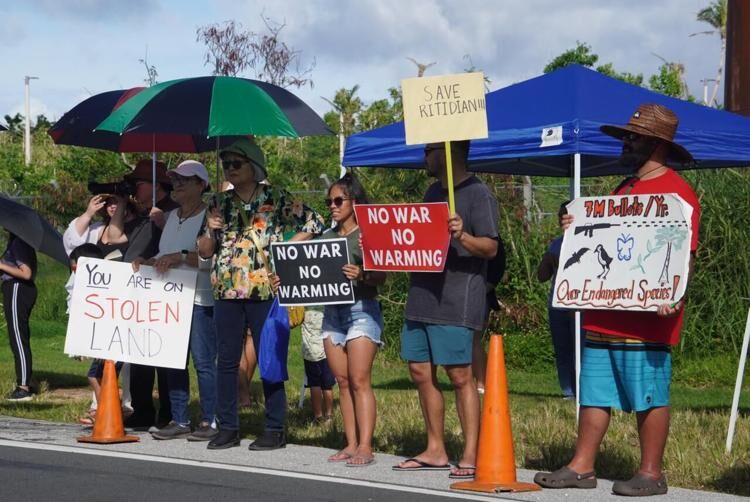HAGÅTÑA (The Guam Daily Post) — About three dozen protesters made up of the descendants of original Ritidian landowners, activist groups and their supporters gathered beneath the heat of the afternoon sun Monday as they stood in protest at the entrance to the live-fire training range at Northwest Field in Yigo, situated above Ritidian Point.
The Mason Live-Fire Training Range Complex, or LFTRC, will consist of five ranges, including a multipurpose machine gun range, anticipated to be completed by October 2024. Monday marked the first day that target calibration was scheduled to begin at the LFTRC, which is the first live-fire activity at the site. This will be used to establish a safety buffer area while the ranges are in use, according to Marine Corps Base Camp Blaz publications. Target calibration will run from Sept. 25 to Oct. 27 and from Dec. 4 to Dec. 15.
Construction of the LFTRC is part of the Marine Corps realignment, which will ultimately see thousands of Marines and their dependents transferred from Okinawa, Japan, to Guam. Marine Corps Base Camp Blaz was activated on Guam in October 2020, officially marking the initial operational capability of the base.
However, the construction of the live-fire training range and the general construction of the Marine Corps base have long been met with environmental concerns, and concerns over access to ancestral lands and the treatment of CHamoru ancestral remains.
Several groups made up the protesters that converged at the entrance to the LFTRC on Monday.
Siobhon McManus, with the group Protect Guam Water, said she attended the protest to advocate for access to clean, safe water and to call attention to potential lead contamination at the Northern Guam Lens Aquifer, which could stem from live-fire training activities.
“I’m also protesting the beginning of testing at the live-firing range training complex because it sits atop Guam’s single-source aquifer. The aquifer … provides over 85% of our population with clean water,” McManus said.
“In a 2012 study released by the (U.S. Environmental Protection Agency), they found that in soils surrounding firing ranges at over 30 U.S. military installations, they found lead contamination in the soil. And because lead contamination can travel through the surface via rainfall … down towards the aquifer, … the lead contamination poses a threat because 7 million lead bullets per year are going to be fired directly on top (of) the soil that is on top (of) the aquifer,” McManus added.
Maria Hernandez May, a descendant of an original Ritidian landowner, said she became involved with activism because of her family’s fight for the return of Ritidian lands, which were condemned by the U.S. military after World War II and are now held in trust by the U.S. Fish and Wildlife Service. She added that there are “so many” environmental and cultural impacts associated with the firing range, including concerns over drinking water contamination and closing off about three miles of ocean extending out from the LFTRC – part of a surface danger zone in the area when ranges are in use.
A final rule published by the U.S. Army Corps of Engineers, effective November 2021, stated that the Marine Corps has an annual goal to use ranges at the LFTRC for 70% of 242 available days per year, or 169 days.
“Therefore, if the Mason LFTRC meets the goal of 169 days per year, then the active areas of the danger zone would be restricted intermittently for 24 weeks,” according to the Army Corps of Engineers final rule.
The machine gun range would have the largest danger zone, and is the only range that would preclude access to portions of publicly accessible areas of Ritidian when in use, the final rule stated. It added that the U.S. Navy has an agreement with the Guam National Wildlife Refuge to establish new recreational activities west of the existing refuge, which would ensure public access year round.
But May said her family never consented to their land being used as a buffer zone for the LFTRC.
“My tata, when his land was taken in the 1960s, and he was given condemnation papers that said, ‘You are no longer allowed to live here anymore,’ he protested that until the day that he died. And he told our family to never stop fighting for the return of Ritidian. And so, we’ve been coming out since 2014,” May said.
McManus said she began attending protests around 2014 or 2016, and that she would keep attending protests, as she feels it part of her responsibility as a member of the community and as an indigenous CHamoru.
“I’ll keep coming as long as our safety is at risk,” McManus said.
“I’ll feel good once they halt the firing range altogether. How realistic that feels as a goal, I’m not too sure. But I feel, as a smaller goal, I do hope that more of the community begins to take seriously the water issue. Because I think a lot of people don’t realize that this is a massive public health crisis that is facing our community. … So my goal coming today specifically is to raise awareness for that issue, along with the other things being threatened by the firing range,” she added.

Descendants of original landowners, activists and their supporters hold signs during a community protest against the Marine Corps firing range in Ritidian on Monday, Sept. 25, 2023.











